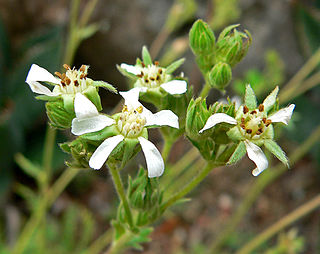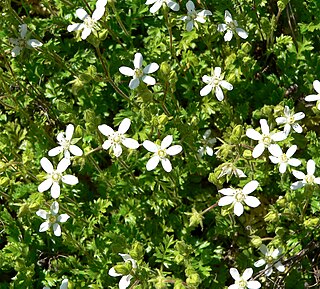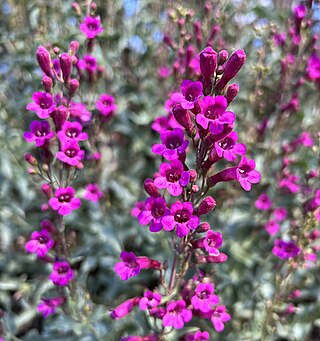
The rose subfamily Rosoideae consists of more than 850 species, including many shrubs, perennial herbs, and fruit plants such as strawberries and brambles. Only a few are annual herbs.

Primula clevelandii, with the common name of Padre's shooting star, is a species of primrose.

Horkelia is a genus of plants in the rose family. It includes several species of plants known commonly as horkelias. These are flowering plants closely related to the cinquefoils (Potentilla) and sometimes considered part of the same genus. There are nineteen species found in western North America, especially California. Horkelia was named for German scientist Johann Horkel.

Helianthella californica is a species of flowering plant in the family Asteraceae known by the common name California helianthella. This wildflower is native to the mountains of California, northwestern Nevada, and southwestern Oregon.
Potentilla bolanderi, also known as border horkelia and Bolander's horkelia, is a rare species of flowering plant in the family Rosaceae. It is endemic to northern California where it is known from only a few occurrences in two or three counties. It grows in the mountain forests of the North Coast Ranges.

Potentilla clevelandii, also known as Cleveland's horkelia, is a species of flowering plant in the rose family. It is native to the Peninsular Ranges of southern California and northern Baja California.

Potentilla lindleyi, commonly known as wedgeleaf horkelia, is a species of flowering plant in the rose family. It is endemic to California, where it grows in coastal chaparral communities and sandy areas.

Potentilla daucifolia, commonly known as carrotleaf horkelia, is a species of flowering plant in the rose family. It is native to the Klamath Mountains and surrounding ranges in northern California and southern Oregon. It grows on mountain slopes and fields, often on serpentine soils.

Potentilla douglasii is a species of flowering plant in the rose family known by several common names, including pinewoods horkelia and dusky horkelia. It is native to the western United States from California to Wyoming, where it is generally found in mountain forests and meadows.

Potentilla marinensis, commonly known as Point Reyes horkelia, is a rare species of flowering plant in the rose family. It is endemic to the California coastline, where it is known from about Fort Bragg to near Santa Cruz. It grows on beaches and in other sandy coastal areas.

Potentilla parryi, commonly known as Parry's horkelia, is a species of flowering plant in the rose family. It is endemic to California, where it grows in the chaparral of the Sierra Nevada foothills.

Potentilla sericata, commonly known as silky horkelia, is a species of flowering plant in the rose family. It is native to the Klamath Mountains of northern California and southern Oregon, where it grows in the chaparral and forest, often on serpentine soils.
Horkelia truncata is a species of flowering plant in the rose family known by the common name Ramona horkelia. It is native to the Peninsular Ranges of southern California and northern Baja California, where it grows in the chaparral. This is a clumpy perennial herb forming tufts of erect leaves and stems. The leaves are up to 13 centimeters long and are made up of large oval-shaped leaflets with toothed edges and squared-off, toothed tips. The terminal leaflet of the leaf is sometimes untoothed. The thin stem is 20 to 60 centimeters tall and holds an inflorescence of several flowers. Each flower has short sepals beneath five round white petals. The center of the flower contains a ring of stamens around a patch of up to 80 thready pistils.

Potentilla hendersonii, commonly known as Henderson's horkelia, is a rare species of flowering plant in the rose family. It is known from four populations in southern Oregon, including Mount Ashland, and one population south of the border in Siskiyou County, California. It is a resident of dry forest habitat in the granite soils of the Klamath Mountains.

Potentilla hispidula, commonly known as White Mountains horkelia, is a species of flowering plant in the rose family. It is endemic to the White Mountains, a small range of mountains that straddles the border between California and Nevada east of the Sierra Nevada. It is a resident of dry scrub and alpine and subalpine forest habitat.

Potentilla rydbergii, commonly known as Rydberg's horkelia, is a species of flowering plant in the rose family. It is endemic to the Transverse Ranges of southern California, where it grows in several types of habitat, including pine forest.

Malacothrix clevelandii is a species of flowering plant in the family Asteraceae known by the common name Cleveland's desertdandelion. It is native to parts of the southwestern United States and Baja California, where it can be found most often in chaparral, including cleared and disturbed areas such as slopes recently burned by wildfire. The plant is also found in southern South America where it is an introduced species. It is an annual herb producing a flowering stem up to about 35 centimeters in maximum height. The toothed leaves are largest at the base of the plant, and reduced farther up. The inflorescence is an array of flower heads each bearing rings of pale yellow ray florets roughly half a centimeter long.

Penstemon clevelandii is a species of penstemon known by the common name Cleveland's beardtongue. It is native to southern California and Baja California, where it grows in mountain and desert habitat such as scrub, woodland, and chaparral. It is a perennial herb with upright, branching stems 70 centimeters in maximum height. The thick leaves are oval in shape, sometimes toothed, and 2 to 6 centimeters in length. The inflorescence produces tubular flowers with expanded, lipped mouths. The flower is pink to magenta in color, up to 2.4 centimeters in length, and somewhat glandular on the outer surface.

Potentilla villosa is a species of flowering plant in the rose family, Rosaceae. Its common names include villous cinquefoil, northern cinquefoil, and hairy cinquefoil. It is native to northwestern North America, where its distribution extends from Alaska to Alberta to Oregon. There are records from eastern Asia.

Micranthes californica, known by the common name California saxifrage, is a species of flowering plants.


















